The Poetic Edda: A Study Guide
The Speech of the Masked One
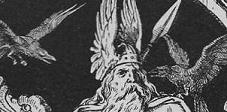
[PREVIOUS][MAIN][NEXT]
[HOME]
MS No. 2365 4to [R]
AM 748 I 4to [A]
Normalized Text:
in Icelandic Poetry
“The Song of Grimnir”
The Yale Magazine, Vol. 16
“The Song of Grimner”
XLIII. Yggdrasil is chief of trees,
That dallies with the wanton breeze;
Let fam'd Skidbladner ever ride,
The fairest Ship that skims the tide:
Odin among th' Asori claims,
Highest honors --- greatest names:
Sliepner with his thund'ring mane,
Is chief of steeds that scud the plain:
Bifrost stands in swelling pride,
Chief of piles that bridge the tide:
Who like Brag, since earliest time,
Can weave the magic web of rhyme?
What bird like Habroc swift in flight?
Or bold in the aerial fight?
What dog with Garmer scents afar
The victims of the sylvan war?
Of trees the greatest is Yggdrasill, of ships
Skithbladner, Odin of the Aser's host,
Sleipner of horses, of bridges, Bifraust, Bragi
Of poets, of hawks Habroc and Gramr of dogs.
in Edda Sæmundar Hinns Frôða
“The Lay of Grimnir”
in Corpus Poeticum Boreale
“The Sayings of the Hooded One”
44. Yggdrasil’s ash is
of all trees most excellent,
and of all ships, Skidbladnir,
of the Æsir, Odin,
and of horses, Sleipnir,
Bifröst of bridges,
and of skalds, Bragi,
Habrok of hawks,
and of dogs, Garm,
(Brimir of swords.)
THE ash Ygg's-steed is the best of
trees, Skidblade of ships, Wodin of Anses, Slipper of horses, Bilrost of
bridges, Bragi of poets, Highbreek of hawks, Garm of hounds, Brimi of swords,
etc.[1]
[1]
enn Br. Sverð] add AM 748.
in Edda Saemundar
“The Sayings of Grimnir”
in The Poetic Edda
“Grimnismol: The Ballad of Grimnir”
44. (43) Yggdrasil's ash, 'tis the best of trees,
but Skidbladnir of ships,
Odin of gods, Sleipnir of steeds,
Bifrost of bridges, Bragi of skalds,
Habrok of hawks and Garm of hounds.
44. The best of trees must Yggdrasil be,
Skithblathnir best of boats;
Of all the gods is Othin the greatest,
And Sleipnir the best of steeds;
Bilrost of bridges, Bragi of skalds,
Hobrok of hawks, and Garm of hounds.
in The Poetic Edda
“The Lay of Grimnir”
in The Elder Edda
“The Lay of Grimnir”
45. [The ash Yggdrasil is of all trees
best;
Skithblathnir, the best of boats;
of holy gods, Othin; of horses, Sleipnir;
of bridges, Bifrost; of skalds, Bragi;
of hawks, Habrok; of hounds all, Garm.]
43. Of all trees is Yggdrasil best,
Skidbladnir best of ships,
Of Gods Odin, of horses Sleipnir,
Bifröst of bridges, Bragi of poets,
Habrok of hawks, and of hounds Garm.
in The Poetic Edda
“Grimnir’s Sayings”
in The Poetic Edda, Vol. III: Mythological Poems
“The Lay of Grimnir”
and Skidbladnir the best of ships,
Odin best of the Æsir, Sleipnir of horses,
Bilröst of bridges, Bragi of poets,
Habrok of hawks, and Garm of dogs.
44. Yggdrasill’s Ash
is the most excellent of trees,
and Skíðbladnir of ships
Óðinn of Æsir
and Sleipnir of steeds,
Bilröst of bridges
and Bragi of poets,
Hábrók of hawks
and of hounds Garmr.
The Elder Edda: A Book of Viking Lore
'The Lay of Grimnir"
in The Poetic Edda, Revised
“Grimnir’s Sayings”
and Skidbladnir of ships:
Odin of the Æsir, Sleipnir of steeds,
Bilröst of bridges, Bragi of skalds,
High-breeches of hawks, Garm of hounds.
as is Skidbladnir of ships,
Odin of the Æsir, Sleipnir of horses,
Bilrost of bridges, Bragi of poets
Habrok of hawks, and Garm of dogs.
Although previous commentators, such as Richard Boer, Henry Adams Bellows and Lee Hollander, have seen this verse as an interpolation into the text, the list of best things is thematically fitting here, providing a natural crown for the coronation ceremony of the new king. Ideally, kings are the best of men. As the new ruler, Agnar will take his place among the best things in life: Yggdrassil, Sleipnir and Odin himself. Due to its final position in the kingship ritual, it is highly probable that the list itself is symbolic in nature.
The list of the best things may also represent a kind of tour of the Old Norse cosmos. As military leader and earthly representative of Odin himself, the king is the conduit of the path the Einherjar will take, from Hel up the Bifröst bridge, to Valhalla where Bragi will welcome them into the ranks of the Einherjar, feasting with the Gods gathered there at the top of Yggdrasil.
Carla O'Harris observes:
This list of the HIGHEST things also represents a 'tour in miniature' of the cosmos. Here the king is as a priest, a connection between Midgard and Asgard. This in turn must be connected to the function of a king: to bring things to their highest focus. To pull things upward, which makes me think of Gronbech. He speaks of the King and Luck. Luck is, in part, the ability of things to be effective, and the king, by bringing excellence to its highest peak of focus, pulls luck up.
Some quotes from Gronbech's Culture of the Teutons seem relevant here:
"To get a comprehensive view of the king's luck, we have to ask: what was demanded, in the old days, to make a man a true king? War-speed, the power of victory, is but one of the distinguishing marks which place the leader in a class apart from everyday characters. His constitution is marked throughout by greater strength and hardihood. Life is more firmly seated in him, whether it be that he is proof against weapons, or that they seem, perhaps, to turn aside from the spot where he stands.
"In the ancient wise, it is said of Harald Hilditonn, that Odin had granted him immunity from wounds, so that no cutting edge could scathe him. And even though perhaps such a degree of hardiness was only found among the very few particularly favoured, we must presume that the king had this advantage over ordinary warriors, that his wounds healed more easily and more completely. At any rate, he possessed a healing power which could be communicated to others.
"At the time when Olaf's brother Harald Hardrada and his son Magnus reigned jointly over Norway, a mother came with her son, who had lost his memory, to ask advice of King Harald; the king opined that the patient suffered from dreamlessness, and counselled her to let the boy drink of Magnus' washing water, and thereafter sleep on Magnus' couch. The effect was instantaneous: both kings appeared to him in a dream, and said: the one: 'Have health,' and the other: 'Have quickness and memory,' and then the boy woke laughing, having recovered the power of remembering. The kings of the Franks had not less of this healing power: a mother cured her son with a decoction from the fringe of King Gunntbram's cloak. In earlier times, it was presumably a common belief that the king had 'hands of healing', as we find in the invocation of Sigdrifa: 'Give us two athelings (herself and Sigurd) speech and wit and hands of healing, while we live.'
"The most violent attacks of nature, too, fell scatheless upon the king's luck. 'Kings never drown,' said William Rufus when he put out into the Channel in a boat during a gale, to quell a revolt in Normandy on its first outbreak. Olaf the Saint, on his crossing to Norway, was in great danger during a storm, but 'the good men with him, and his own luck, brought him unscathed to land.'
"At any rate, it was one of a chieftain's natural attributes, that his luck always gave him a favouring wind. The waters, too, carried shoals of fish in to the ruler's lands, we may suppose; it is said of Earl Hakon, that in his time, fish came up into all the fords. Luck of fertility prevailed over his fields, giving close ears of corn and good weight in the ear."
It's interesting in this regard to note that some of the characteristics considered native to Kings are precisely those powers conferred on them by Rig's runes -- ability to allay the winds, etc.
"'It is hard to fight against the king's luck,' and 'Much avails the king's luck'; thus old saws sum up the hardness and the massiveness of the chieftain's gift, and the wisdom implied in these sayings amounts to such sage counsels as this: One must not set oneself athwart the great man's luck, but let oneself be borne on by it. When a man entered the king's ranks and let his own war-luck be inspired by the higher, he became, in the most literal sense, worth more himself. The king was so full of luck that he could radiate it out to all those near him and could even send it away to act at a distance. If one could get a chieftain to approve an enterprise by his words: 'I will add my luck,' then one had his war-luck in one's weapons, his weather-luck in one's sails. Of such a man it can simply be said: 'He goes not alone, for king's luck goes with him.' And a request to undertake a desperate enterprise on the king's behalf was often granted with the words: 'I will attempt it with your luck.' A man in the king's favour, as for instance Hallfred the Wayward Scald, lived all his life in the shadow of the king's luck. When on one occasion he was attacked from behind, he prayed to Christ for aid, and succeeded 'with God's help and by Olaf's luck' in beating off the attack. His opponents knew him for a man protected by special favour, and were cautious in attacking him; his bitter foe, Gris, whom he had injured most bloodily by ravishing his wife, was glad of a chance to avoid meeting him in single combat, and declared that he was 'loth to fight against the king's luck'.Gronbech waxes eloquent and evinces more examples from the Icelandic Sagas, but this gives the flavor. Note Gronbech's words "comprehensive perfection." This is Arete, excellence, the "best" of things, the æðstr. Cleasby/Vigfusson translate this as "highest." Thus, the list is there to inspire people towards the highest, and to remind the king of his function of providing an example for the tribe on earth of aspiration. Without aspiration, people do not come into their full natures. There are beautiful, wonderful, majestic things, and everyone, but the king/chieftain most of all, should aspire to be as excellent.
"This comprehensive perfection, moral and physical, belonged to the nature of chieftainship. Even a petty village leader was expected to stand firmly by the rights of his friends, and see that none encroached on them; he must be so respected that outsiders were loth to interfere with them. Any man in the village had the right to bring an injury he was unable himself to repair to the door of the chief, and if it were left there unavenged, it brought down infallibly nidinghood upon the chieftain's whole race. It needed strength to take up such an heritage. And when disputes arose within the district itself, the chieftain was the proper person to put matters right, to solve the difficulty, so that “all were content with his decision”. When we call to mind that the king, in such a case, found himself placed between two "honours", both equally susceptible and equally indispensable, we may presume that he would need to be gifted with a very high degree of craft and ingenuity — and generosity withal, so that he was not afraid of sacrificing something of his own in order to heal a wounded honour."
It also has a rebuking function. By naming these best of things, this is what you have to live up to. Will your kingship be as excellent as Yggdrasil is of trees, Skidbladnir of ships, etc? Moreover, this aspiring and rebuking list also draws up and accentuates how important the other values in the poem associated with kings are. If a king is to be excellent, he must treat guests well, he must be wary and investigate and penetrate through slander (and not act according to rumors). He must not be stingy. He must share food and be generous. ALL OTHER QUALITIES OF KINGSHIP PRESENT, THESE QUALITIES LACKING, HE IS A NITHING. This seems to be the point of this poem. The MERCY (UNMERITED FAVOR) that Agnar shows to Odin — in appearance, just some poor stranger who has been slanderously accused of being a villain — is the key that opens a tour of the very HEAVENS.
This crowns the whole list. If all these things are the BEST or HIGHEST, then by implication, a king must be the highest for the MERCY he shows. This is why Balder is the best amongst the Gods, and why his word or judgement cannot be gainsaid. This is why he will rule in the restored world.
|
—BETTER THAN ALL THE REST— Yggdrasill of Trees 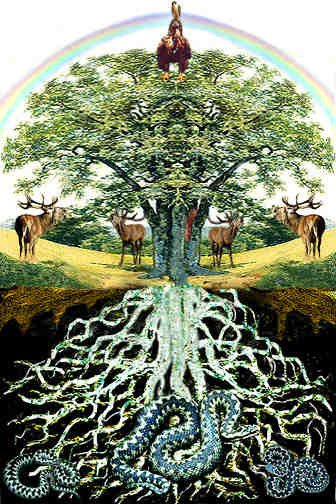 |
Yggdrasill's Ash represents the totality of creation, one of the primary themes of the poem itself. The tree itself has already been explored in detail in stanzas 25-35.
Here the world-tree is called Yggdrassils Askur, its most common designation. The same tree is designated Yggdrasil only once in Voluspa 19, but elsewhere always as Yggdrassils Askur (Grímnismál 29, 30, 31, 32, 34, 35, and 44). The same may have been true of Völuspá 19 at one time. The first lines of the stanza read:
Ask veit ek standa, |
I know an ash standing named Yggdrassil |
However, the Codex Regius text of Snorri's Edda, Gylfaginning 16, reads instead:
Ask veit ek ausinn,* |
I know an ash watered named Yggdrasill's. |
| *Codices Wormianus (AM 242 fol.) and Trajectinus (Traj. Ms. 1374) both read Ask veit ek ausinn, heitir Yggdrasil. Only the Uppsala Codex agrees with the reading from Völuspá (CR and H). | |
Might the original version of these lines have read Ask....Yggdrassils, in agreement with all other instances of the tree's name? Of course, there is no way to know. As it stands, at least one manuscript does.
Like all things in Eddaic mythology, the world-tree has many names. In Grímnísmál 25 and 26, it was known as Lærað. The late poem Fjölsvinnsmál provides three additional designations. The first is Mimameiðr, Mimir's Tree, in stanza 20. The other two are reflexive forms of one another, designating the upper and lower halves of the tree. They are Vedurglasir, the tree of winds, in Fjölsvinnsmál 24, which is comparable to the term vindga meiði, 'the windswept tree" in Hávamál 138, and Aurglasir in stanza 28. Both of these terms are formed on the base Glasir, "the glassy", which Snorri informs us is a tree with golden leaves growing outside of Valhalla's door. The designations Vedurglasir and Aurglasir found in Fjölsvinnsmál thus tell us that Glasir was a name for Yggdrassil, whose branches envelop Asgard. The name Glasir may refer to the transparent quality of the tree, making it invisible to the human eye from Midgard. Vedurglasir is that part of the tree exposed to the winds. Aurglasir designates that part of the tree hidden below the earth, the Glasir of the aur, "soil, clay, loam." Aurglasir, indicating the root system of the tree, is perhaps best interpreted as "the loam tree" (Carolyne Larrington, Poetic Edda, 2014, p. 319).
Skidbladnir of Ships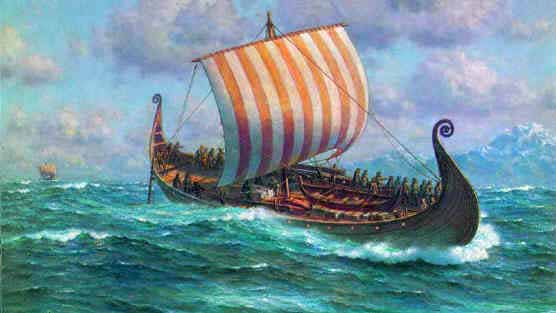 |
Skiðblaðnir, as described in Gylfaginning 43, is a ship big enough for all of the gods to board with their wargear and weapons in tow. It was given to Freyr by the Sons of Ivaldi (verse 43). Ynglingasaga 7 names Odin as its owner. Constructed with 'a great deal of magic," the ship finds a favorable wind as soon as its sail is hoisted, taking it wherever it needs to sail. It is made up of so many parts and with such great art that, when it is not needed at sea, it can be folded up like cloth and placed into one's pocket. The name Skidbladnir itself means "thin slips of wood."
Due to its collapsable nature, Skidbladnir is sometimes compared to the ship procession which travelled by land and water from Aachen to Loos in the year 1133, according to the Gestorum Abbatum Trudonensium (Book 12, Ch. 10-14). In a bog at Nors in Denmark, a clay jar yielded a cache of viking age ships in miniature, beautifully crafted of gilded bronze with concentric circles on the prows. A recurring feature in Bronze Age rock carvings of the same region is the ship, often filled with figures. These lively ship scenes often include sun wheels, phallic figures, and figures dancing or playing instruments, all indicative of ritual activity. Sometimes the ship is carried by a giant figure thought to represent a deity. These carvings strongly imply that collapsable cult ships were carried or drawn in religious processions.
Elsewhere ships are frequently associated with the dead, another
central theme of the poem. Baldur's ship Hringhorn becomes his funeral
pyre in Gylfaginning 49. Ship graves, such as the Oseberg find, often
hold noble figures, and smaller graves marked by standing stones in the
form of ships dot the Scandinavian landscape.
In
Lappland as late as the 1600s, natives placed food, saved from the
Yuletide meal, in a small chest made of birch bark in the shape of a
boat, with sails and oars and hung it on a tree for the use of the
Juhlian Company or Wild Hunt, made up of deceased ancestors which
wandered about in the air at Yule.
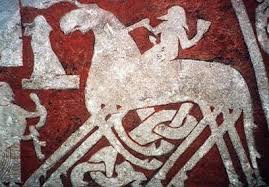 Odin of the Æsir, Sleipnir of Horses |
Odin is the father of the Æsir and the ruler of the gods. He reigns from his throne, Hlidskjalf at the apex of heaven; This is the sixth time (of nine altogether) that the name Odin appears in the poem, and the last time before he reveals his identity to Geirröd.
In Eddic poetry, Sleipnir is only mentioned here and in Hyndluljóð. He is conspicuously absent from the list of horses ridden by the Aesir in Grímnismál 29, although Snorri includes Sleipnir in the same list repeated in Gylfaginning 15. Snorri elaborates on the horse's origin in Gylfaginning 42.
Sleipnir, Odin's eight-legged horse, is one of Loki's progeny, borne by him to the stallion Svaðilfari, according to Hyndluljóð 40. Snorri says that this stallion belonged to the giant who built Asgard's wall for the gods. At Loki's suggestion, the gods wagered the sun, moon and Freyja that the giant-builder could not complete the fortification in the space of one year. But, with Svaðilfari's aid, he came so near to finishing it the gods feared he would win the wager. To delay the giant's progress, Loki transformed himself into a mare, luring the stallion away. Without the stallion's assistance, the giant failed to complete his task within the stipulated time, and fell before Thor's hammer when he objected violently. Loki soon returned with the eight-legged foal Sleipnir, whom he gave to Odin.
Sleipnir is Odin's personal transport, and a physical embodiment of Yggdrasill, which itself means Yggr's horse. Odin is known as Yggr in Váfþruðnismál 5, Grímnismál 53 and 54, Hymiskviða 2 and Fáfnismál 43. The more common phase Yggdrasills Askur can thus be interpreted as the "Ash of Yggr's horse." Ash (Askur) refers to both the Tree and Askur, the first man. Therefore, the "Ash of Odin's horse" may indicate "the man or rider of Ygg's horse," which refers back to Sleipnir's master, Odin. The meaning of these terms cannot be established with certainty, and has been widely discussed by scholars.Eiríkr Magnússon's insightful essay "Odin's Horse Yggdrassill" (1895) speculates about the nature of Odin's famous horse. According to his theory, Sleipnir, which means "the Slipper", is sired by Svaðilfari, "he who fares over svað," referring to a thin layer of mire over frozen soil, caused by a thaw. The notion of slipperiness is always implied when walking over svað. Sleipnir is the slip-footed, or nimble-footed.
Further, Eiríkr suggests that Sleipnir's eight legs represent the eight winds, blowing from the four cardinal points of the compass and the points in between. The four cardinal directions are the same throughout the Germanic languages, with slight variation, while the names for the other four directions are peculiar to the coastal inhabitants of Norway, having developed independant of southern Germanic influences. Accordingly, Sleipnir represents the wind blowing through the vast expanse of Yggdrassil's branches. In that case, the term Yggdrassils Askur would mean "The Ash of Odin's horse", "The Ash of Sleipnir" or more transparently, the "Tree of Winds." Sleipnir, Odin's primary means of travel, is thus a symbol of the wind blowing through the "wind-swept tree" (vindga meiðr) from which Odin, in the early days, hung nine long nights with no food or drink, when he first received a drink from Mimir's fountain (Hávamál 138-139). Only then did Odin "began to quicken and be wise, to grow and to prosper" (Hávamál 141), allowing him to become the king of the gods. Today, Odin will pass that same knowledge down to Agnar.
Bilröst of Bridges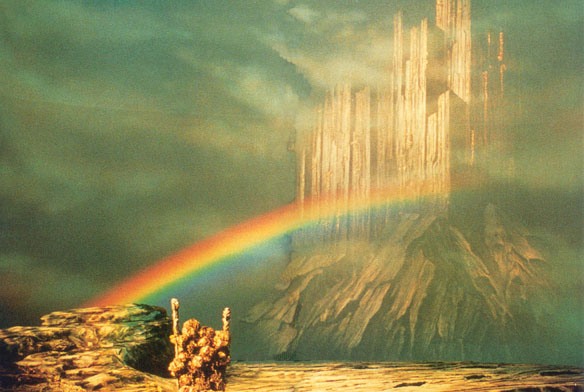 |
Bil-röst, an alternate name for Bifröst, "the trembling way," is the pathway to heaven. In stanza 21, the same span is called "Þjòðvitnir's fish" and ásbrú in stanza 29.
Stanza 30 contains a roster of the horses the gods ride daily to sit in judgement at Urd's well. Sleipnir is not among them. He doesn't require the bridge to move between worlds. While it is possible for powerful horses to swim in the strong currents of air, stanza 21 informs us that "it seems impossible for the hosts of the slain to wade through its streams." Thus Bifröst forms a necessary connection between heaven and Hel, allowing the horses of the gods to move efficiently through the air. When Surt's men arrive from the world of fire in the deep southern regions of the underworld, the bridge will break under the weight of riders, and the horses will be forced to swim in the 'great river' (Fáfnismál 15). According to stanza 21, it is the same path over which the Einherjar arrive in Valhalla. Thus, fallen warriors do not arrive in Valhalla directly from Midgard, but from Hel.
It is evident from the sources that warriors destined for Valhalla must go to Hel first. Fáfnismál 10 informs us that "all men come to Hel" when they die. Gisli Surson's Saga (ch. 24) confirms this, when it says that it is custom to bind Hel-shoes on the feet of the dead; even those destined for Valhalla. In Gylfaginning 49, Hermod on Sleipnir is said to make more noise than five troops of dead men crossing into Hel before him. Their great numbers and identification as fylki ('military troops') indicate they were killed together on the battlefield. In Hákonarmál, Odin sends the valkyries Göndul and Skögul "to chose kings of Ingvi's race, to come to Odin and abide in Valhal." Skögul responds saying "We two shall now ride over græna heima goda ("green realms of the gods") in order to tell Odin that a great king is coming to see him." By "green realms of the gods," Skögul cannot mean the blue ether. The "green realms" through which they pass are the verdant realms of the lower world. Likewise, when Odin rides to Hel to receive news of Baldur's fate, foldvegur "paths through green fields" resound under Sleipnir's hooves (Baldurs draumr 7). The gods ride over Bifröst daily from their homes in heaven to sit in judgment by Urd's well. Sólarljóð 51 tells us that dead men gather there, sitting on "Norn's seats," no doubt awaiting their day in court, to determine their final fate.
When Hakon Jarl and Erik arrive in Valhalla in the company of other kings, the path trembles beneath them. Idunn's husband, Bragi the bard and the hero Hermod welcome them. When Hakon arrives, his troops make so great a noise that Bragi wonders if it isn't Balder returning from Hel. Bifröst was thus conceived of as a conduit between heaven and Hel. The bridge does not lead to Midgard. It stands outside and below the edge of the earth's crust both in the north and the south. In the south it descends from Asgard to Urd's well and to the thingstead of the gods in the lower world. To get to the southern end of Bifrost, Hakon and Erik with their men must have first journeyed to Hel, across the river Gjöll, and past the thingstead of the gods near Urd's well. There one finds Bifröst's southern bridgehead.
| Bragi of Skalds |
The anonymous Eiríksmál (stanza 3) and Eyvindr Finnsson's Hákonarmál (stanza 4), both place Bragi in Valhalla, welcoming fallen kings and their men into Odin's hall, which may be precisely why his name is included there. Known from Grímnismál 44, Lokasenna 11-18, Helgakviða Hundingsbana II, 26 and Sigurdrifumál 16, Bragi is the master-poet of the gods. Idunn is his wife. Scholars have long speculated that the god Bragi may be the 10th century Norwegian skald, Bragi Boddason, elevated to divine status. In Norse mythology, Bragi is most likely the son of Odin and Gunnlöd, the giantess who helped Odin obtain the poetic mead. According to Hakonarmál, Bragi and Hermod greet the Einherjar as they arrive at Valhalla over Bifröst. In the late eddic poem Hrafnagaldur Óðinns, Bragi travels over Bifröst with Heimdall and Loki to the underworld in search of his wife Idunn.
Hábrók of Hawks, Garm of
Hounds 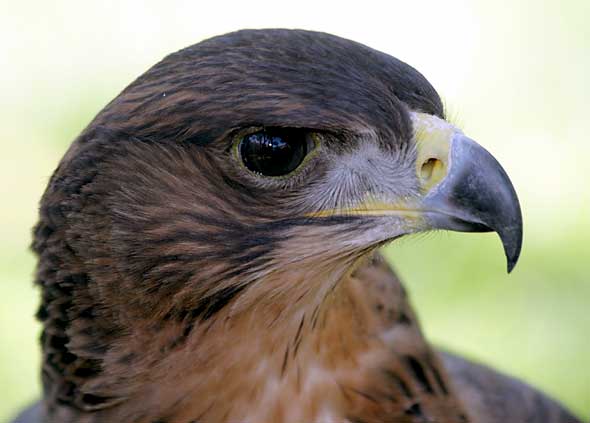 |
The list of best things continues. Hábrók (High-breeches), the best of hawks, may allude to the hawk perched between the eagle's eyes, atop Yggdrasill at the apex of heaven, mentioned in the so-called Lost Verse of Grímnismál, modeled on Gylfaginning 16.
In contrast to the hawk perched in the heights, Garm, the best of hounds, is a watchdog in Hel, howling in chains before the Gnipna-cave in Völuspá 44. He will break free at Ragnarök. In Gylfaginning 51, Snorri says that Tyr, the one-handed god, and Garm will fight to the death.
John Lindow, Norse Mythology: A Guide to Gods, Heroes, Rituals, and Beliefs (2002), writes:
Stanza 44 has a list of things that are best in the mythological world: Yggdrasil of trees, Skídbladnir of ships, Odin of æsir, Sleipnir of horses, Bilröst of bridges, Bragi of skalds, Hábrók of hawks, and, finally, Garm of hounds. In this company we would expect Garm to be a positive figure, but in his only other appearance in poetry, repeated three times more or less verbatim in Völuspá (stanzas 44, 49, and 58), he is anything but:
Garm howls loudly before GnipahellirThematically, the hawk and the hound may represent a vertical sweep of the world-tree (and therefore of the universe) from top to bottom, just as Bifröst provides a horizontal sweep of the cosmos in the north-south direction. Together they represent the totality of the universe, represented by Yggdrassil, the best of trees.
the bond will burst and the wolf will run free.
Axel Olrik, The Heroic Legends of Denmark (1919) notes:
The hawk Habrok and the dog Garm. Common to both sagas is the story of how Hrolf's hawk Habrok is caged together with the thirty hawks of the Swedish king so that they shall claw him to death; but Habrok kills all of them. Of Garm we are told in the Hrolfssaga that he rends a charmed boar sent against him by Athisl. One may be inclined to consider these elements late additions to the story; but it is well to recall that in the Elder Edda there are two lines saying that Habrok is the best of all hawks, Garm the best of all dogs.* ...It would seem, then, that the strong beasts of prey were associated with Hrolf kraki at a comparatively early time. Just as he is given a large company of berserkers to accompany him in war, likewise these animals are associated with him, personifying his heroic nature still more clearly.
The very fact that Hrolf is pictured with these warlike and heroic symbols is a new feature. Neither the Biarkamal nor the Danish stories are specific in this regard. The strong, fierce dog is the characteristic heroic animal in the Norn hero tales. Olaf Tryggvason has his hound Vigi who tears Thorir hjortr (the Hart) who has changed himself to a stag; the dog Snati follows Gest Bartharson to the Giants' cave and participates in the battle that takes place there; Ole froekni's dog fells one of the robbers whilst his master kills the other; in Saxo's Frithleifssaga, Biorn's powerful dog fights by his side and helps the king to gain the victory. In these heroic legends from the early Middle Ages King Hrolf with his two animals Habrok and Garm suits very well.
...AND
BRIMIR OF SWORDS 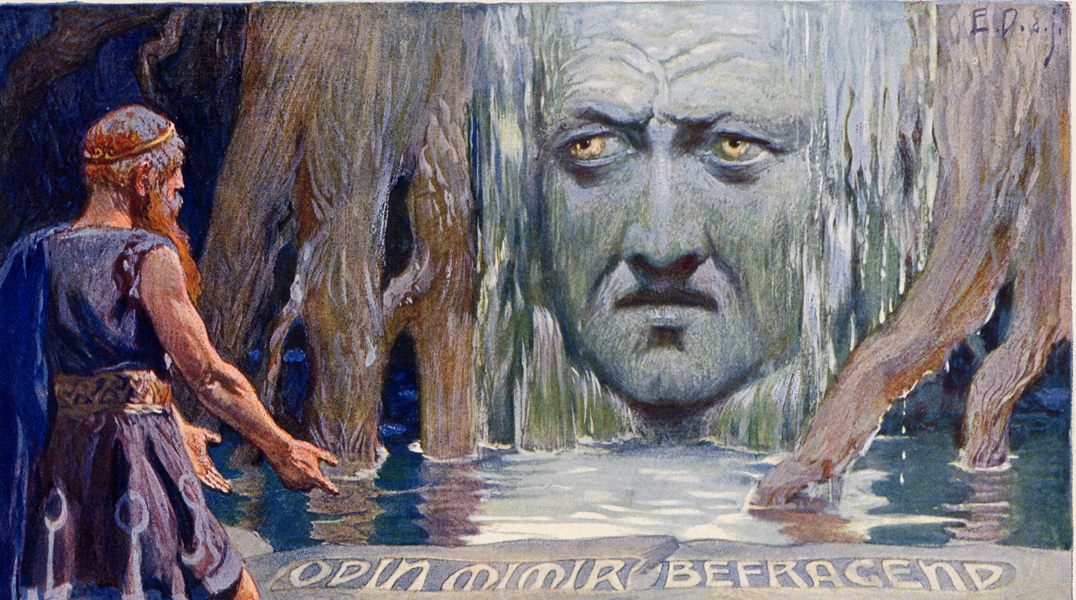 |
To the list of best things, the variant text in vellum AM no. 748 adds ænn brimir svæða, "and Brimir of swords." A similar expression occurs in Sigurdrifumal 14, which may aid our understanding here:
|
14. Á bjargi stóð |
14. On a mountain he (Odin) stood, with Brimir’s sword, a helm on his head he bore. Then spake Mim’s head its first wise word, and true saying uttered. |
Snorri Sturluson provides a possible explanation for this odd expression. In Skaldskaparmal #, Snorri informs us that the expression “Heimdall’s head” is a metaphor for sword. Thus a head can be called a sword, and a sword a head. In Skaldskaparmal 69, Snorri writes:
"On a man there is what is called a head. This shall be referred to by calling it ...Heimdall's sword, and it is normal to use any term for sword you like and qualify it by one or other of Heimdall's names."
Similarly, in Hrafnagaldur Óðinns 14, Heimdall’s head is characterized as a sword.
|
14. Dofna þá dáðir |
14. Actions are numbed, the arms slump, a swoon hovers over the white god's sword (i.e. “Heimdall’s head”); stupor dispels the wind of the giantess (i.e. “the mind”) the mind's workings of all mankind. |
This allusion can be explained in the greater context of the mythology. In Gylfaginning, Snorri informs us that Loki and Heimdall cause one another's death. In Skaldskaparmal 8, he elaborates on this. He says:
"A sword is called Heimdall's head, it is said that he was struck through with a man's head. He is the subject of the poem Heimdalsgaldr and ever since the head has been called Heimdall's doom, man's doom is an expression for sword."
We can imagine that when Heimdall cut off Loki's head, an event foreshadowed by the contest of the artists, in which Loki lost his head in a bet to the dwarf Brokk, but kept it through a clever ruse (Skaldskaparmal 42), that his decapitated head penetrated Heimdall's chest, killing him. This is naturally explained by the description of "Uthgarlocus" or Utgard-Loki in Book 8 of Saxo Grammaticus' Danish History, which seems to be a description of Loki himself, after being bound in the underworld. There a group of human adventurers, encounter a bound giant in the land of the dead. His hair and beard are grown out into deadly horns. The mediveal image of a horned Satan bound in the underworld may have originated with Loki, as Satan is not described as horned in the Bible, but merely bound like Loki, awaiting the final battle.
When Sigrdrifumal 14 says that Odin stood with “Brimir’s sword” and then tells us he speaks with “Mimir’s head”, we should recognize the possibility that these may simply be two different ways of saying the same thing. Since a sword can refer to a head, then "Brimir's sword" may simply mean "Brimir's head". Thus, in this context, Odin is speaking with Mimir's head, this interpretation is not only possible, but probable.
Brimir’s sword= Mimir’s head, therefore Brimir is another name for Mimir. This theory can be demonstrated by applying that meaning to the other instances where the name occurs.
The name Brimir appears in several Eddic poems, most notably Völuspá 9:
|
9. Þá gengu regin öll |
“Then all the Powers
went to the thrones of fate, The sacrosant gods, and considered this: Who should create the lord of the dwarfs Out of Brimir’s blood and from Blain’s limbs?” [Carolyne Larrington tr., 2014] |
And again in verse 37:
|
37. Stóð fyr norðan |
37. On the north there stood, on Nida-fells, a hall of gold, for Sindri’s race; and another stood in Okolnir, the Jötuns beer-hall which is named Brimir. |
Here Brimir is the name of a giant (a jotun) who owns a "beer-hall." Like Mimir, Brimir is a jötun, a giant, who possesses a drinking-hall. Mimir is well-known for his drinking. In Völuspá 28, he is said to drink mead every morning. His hall is located near the golden hall of the dwarf Sindri. According to Snorri, Sindri is the dwarf who forges Thor's hammer, and Frey's golden boar Gullinbursti. Here as in the German heroic poems, Mimir (Mimi die alt) is associated with the dwarf smiths. So within Völuspá, the name Brimir refers to both Ymir and Mimir, this is naturally explained if they are father and son. Vafþrúðnismál informs us that Ymir had two children beneath is arm, a boy and a girl.
|
33. "Undir hendi vaxa |
33. Under his armpit grew, it is said of the Frost-giant (Ymir, called Aurgelmir) a girl and boy together; foot with foot begat, of that wise Jötun, a six-headed son. |
Simple deduction dictates that these children are giants and among the oldest beings in the universe. The poem goes on to identify the six-headed son begot by the old giant's feet as Thrudgelmir, the father of Thrudgelmir, from whom the hostile jötuns are descended. The mythology also knows a race of friendly giants, helpful to the gods. This passage seems to ascribe them a more noble origin from under Ymir's arm, rather than those begotten asexually from his two feet together. They form a heatrosexual pair, male and female. The helpful giants Mimir and Urd, both undisputed owners of the world-wells which feed Yggdrassil are the only logical choice. Naturally they are older than the Sons of Borr (Odin and his brothers) who go on to create and rule the upper worlds formed from Ymir's corpse, and not subject to them. Even Odin is subject to Urd's edicts, the laws of fate, and must sacrifice of himself to obtain a single draught from Mimir's well.
The names Blainn and Brimir are a subject of scholarly discussion. Their meanings are uncertain. Generally, both are seen as alternate names for Ymir, thus the dwarves are created from Ymir's blood (the sea) and Ymir's bones (the rocks). Thus Ursula Dronke's commentary on this verse in her Poetic Edda, Vol. II, pp. 121-122. Snorri tells us that the dwarves originated as maggots in Ymir's flesh. Since Ymir was the primeval giant whose body was used to create the earth, this seems plausible.
Although we find additional information about Brimir in Eddic poetry, the name Blainn is not found again. It means "the black one" or "the blue one." Since this passage directly refers to the creation of the dwarves from his limbs, i.e his flesh, Blainn most likely refers to Ymir. In the creation of the dwarves, Brimir again plays a role, according to Voluspa 9. The dwarves are created from “Blainn’s limbs” and “Brimir’s blood”. Brimir also appears to be a name of Ymir, but may also refer to his son Mimir. We know that Ymir was slain by the sons of Borr, who inflicted a "neck-wound", beheading him and using his skull to create the dome of the sky, and gathering his blood to form the sea (cp. Grímnismál 40-41). The imagery seems to invoke the hlaut-bowl used to catch the blood of a sacrifical victim. At some point Mimir was beheaded as well. The same fate appears to have befallen Vafthrudir, the giant who loses a wisdom contest with Odin (cp. Vafþrúðnismál 19).
As the son of Ymir, Mimir may also be called Brimir. We have already seen above that a head can be called a sword, and reflexively that a sword can be called a head. Similarly, in skaldic usage, any liquid can be used to describe blood, and visa versa. This occurs in Eddic poetry as well. The most obvious parallel example I can think of is Fáfnismál 14. There Sigurd asks:
|
4. "Segðu mér þat, Fáfnir, |
4. “Tell me then, Fafnir, for wise thou art famed, And much thou knowest now: How call they the isle where all the gods and Surt shall mingle sword-liquor (hjörlegi)?” |
The word hjörlegi means “sword-liquid”. The word is derived from lögr which means:
1) sea
2) large lake
3) water or any liquid.
Thus, blood is described as the liquid or water of the sword. Many examples of kennings of this type can be found. Reflexively, a liquid such as water may be called the blood of the container that holds it, or its owner. Thus, “Brimir’s blood” may mean nothing more than “Brimir’s liquid”. If “Brimir’s blood” refers to “Mimir’s water” or “Mimir’s liquid”, this need not be his actual blood, but simply water from his well, which is well-known to have creative properties. The water in his well seems to have great power, and is coveted by the gods. Odin pledges one of his eyes for the wisdom this well can bring, and gains 9 fimbul-songs in exchange for his sacrifice.
Perhaps then, the dwarves, who were created from “Brimir’s blood and Blainn’s bones” are formed from the matter of Ymir’s body, and the wisdom or creative power found in Mimir’s well.
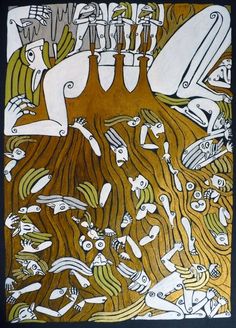
Helena Rosava
The Death of Ymir
[PREVIOUS][MAIN][NEXT]
[HOME]